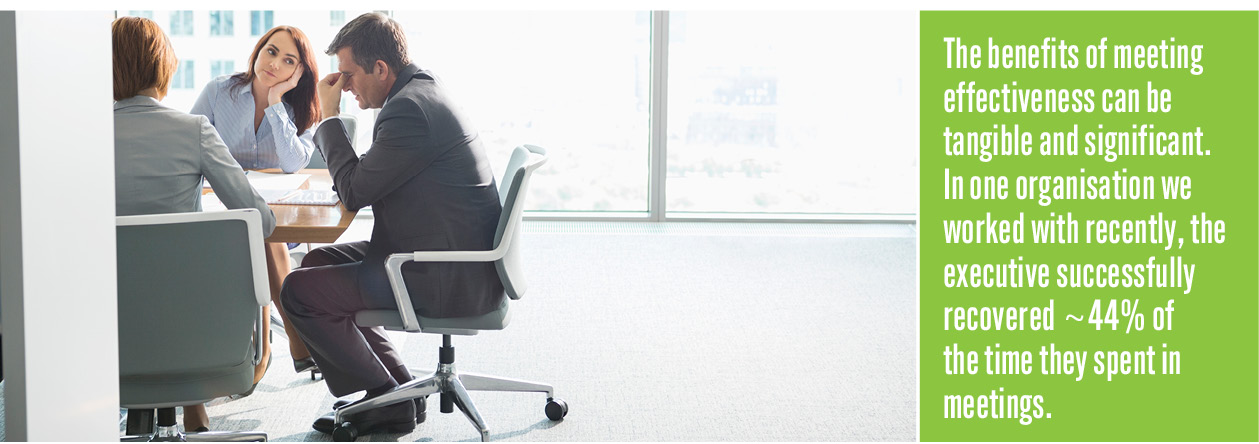Liberate resources by running meetings more effectively
by Dr Marc Levy & Dr James Mills
Right Thinking
In many ways, reclaiming time lost in meetings is like improving physical fitness. The best way to shed the pounds, or in this case reclaim precious hours, is through a strict diet, training and persistence. In this case the ‘diet’ involves cutting back the minutes spent in meetings by pruning unnecessary interactions, inviting to participate only those whose input is required and protecting time for independent work. This ‘diet’ should be accompanied by a training regime designed to enhance meeting effectiveness to deliver meaningful progress during every interaction. Like all fitness regimes, persistence is the key to making the changes stick. However, once effective disciplines are embraced, meetings can become a place to get ‘real work’ done together, rather than a distraction.
We frequently hear clients complain about how much time they spend in meetings. Meetings are too long and/or too frequent. The right people aren’t in the room. More people are invited to attend than necessary. There is no agenda. Roles are unclear and there is no moderator of the discussion. Outcomes are opaque. The minutes or actions arising are distributed too late or don’t get followed up at all. Meetings are a source of pain for many organisations and in recent years we’ve found that clients are increasingly looking to us for help to improve the efficiency and effectiveness of their everyday interactions.
Improving your organisation’s ‘meeting fitness’ is more than just an exercise in operational hygiene. The benefits to be realised are tangible and significant. We typically conduct a diary analysis at the start and end of ‘meeting fitness’ programs to gauge their impact. For one organisation we worked with recently, the program allowed the executive team to recover ~44% of the time they spent in meetings (excluding conferences). In addition, heads of department attended 14% fewer meetings and across the whole organisation there was a 26% increase in short, targeted stand-up meetings.
In a tight budgetary climate, when it can be challenging to have executive teams and boards approve new headcount, freeing up capacity to get more done, or new things done, is vital – as is, of course, initiative prioritisation and resource allocation effectiveness, topics canvassed in previous Right Lane Review articles. In this article we present the five stages of a successful ‘meeting fitness’ regime: prune, participate, protect, progress, and persist.
1. Prune
When helping clients to reclaim hours spent in meetings we typically begin with a ‘calendar purge’, a thorough evaluation of the organisations recurring meetings. In conducting this evaluation, we challenge organisations to consider the following questions for each recurring interaction:
Does this meeting have a specific purpose (and a clear output)?
Where the above outputs are communicative, is a meeting the best format for this?
Is the time allocated for this meeting appropriate?
Is the format of the meeting (stand up/sit down/teleconference) appropriate?
2. Participate
Too often, people are invited to attend meetings for which their input is not required on many, or even all, of the agenda items. Trimming down meeting invitations to include only those who need to be there, and where possible to only the parts of the meeting for which they are required, not only frees up their time, but will also lead to crisper, more targeted discussions during meetings. For this to work best, it is important to empower individuals to excuse themselves from meetings when they believe their input is not required.
3. Protect
Most of us are familiar with the ‘dead time’ caused by awkward intervals between meetings. When managing multiple calendars, this can be difficult to avoid. However, protecting blocks of time can help to consolidate meetings and significantly reduce ‘dead-time’. We encourage the organisations we work with to trial practices such as ‘No meetings Monday’ to protect valuable blocks of time for progressing independent work.
Many individuals in your organisation may already attempt to protect time in their calendars in a similar way. However, introducing these initiatives at the ‘whole of business’ level gives staff licence to ‘stick to their guns’ when under pressure to schedule meetings that encroach on protected time.
4. Progress
Adopting best practice meeting disciplines is the key to ensuring that your team’s interactions result in meaningful progress. When these disciplines are lacking, meetings can easily be consumed by tangential discussions and often fail to achieve the necessary outcomes. As a result, meetings overrun or are inconclusive and the same agenda items get tabled again and again.
Having facilitated close to 1000 executive team and board workshops, we understand how to run meetings effectively. Often, as we work with client CEOs and chairs to develop session agendas, we find that they are sceptical about how much ground we intend to cover. `We’ve spent hours debating this issue and haven’t cracked it yet’ and ‘there are a lot of strong personalities in this group’ we are warned. However, at the end of the workshop, one of the most common reflections we hear is, ‘Wow, I can’t believe how much we got done!’.
Improving meeting effectiveness is the key to making sure that meetings result in meaningful progress. It is a discipline that can yield a very high efficiency dividend. One of our senior clients estimates that he spends 60-80% of his working day in meetings and that 30% of that time is wasted. Improving meeting effectiveness can liberate between 100 and 200 hours per week of top team time, and many hundreds of hours for the ‘CEO+2 level’ group.
The opportunity is huge; however, like any fitness regime, going it alone can be tough. We help clients improve their meeting effectiveness by observing their meetings, recommending new policies and practices, upskilling their people in the new approach and helping to embed the required changes.
One practice that we frequently recommend relates to ‘the Ps of meeting effectiveness’. There are various lists of between five and eight Ps (see, for example, Schuman 2005) and different lists work in different contexts. Our own Right Lane five Ps are: purpose, product, perspective, people and process. We expect meetings to have an agreed purpose, a clear process and end product, and so on. In consulting we want our people, particularly our analysts and junior consultants, to have a perspective. Participants in our meetings are expected to have a view on the issues to be raised in the meeting and to ‘get in the game’, which means be heard and have an impact in meetings.
5. Persist
Like any fitness regime, getting (and staying) ‘meeting fit’ requires persistence. However, once effective disciplines become embedded they can have a strong positive impact on an organisation’s ways of working.
One of our most successful clients spends a high proportion of their time in meetings, and they have a different attitude to this investment in time than many of our other clients. They get ‘real work done together’ in meetings; they don’t see meetings as a distraction from their real work or what they have to get done. There are several reasons for this, but one of the most important is that their meetings are well run and the usual frustrations that accompany meetings are largely absent.
Let’s fix meetings so that they can be the powerful site of action and collaboration that they should be.
References
Schuman, S (ed) 2005, The IAF handbook of group facilitation, Jossey-Bass, San Francisco
© 2019 Right Lane Consulting
We hope the ideas presented here have given you something new to think about. We would love the opportunity to discuss them with you in more detail. Get in touch today.


